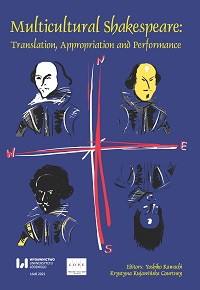An Unexpected Journey “from the naves to the chops”: “Macbeth”, Animal Trade, and Theatrical Experience
DOI:
https://doi.org/10.18778/2083-8530.24.06Keywords:
Macbeth, posthumanism, early modern animal trade, historical phenomenologyAbstract
The paper proposes to appreciate the play’s butcheries as an incision into the unstable character of the category of the human. The vividness of the “strange images of death” is thus analysed with reference to the cultural poetics of Elizabethan theatre including its multifarious proximity to the bear-baiting arenas and execution scaffolds. The cluster of period’s cross-currents is subsequently expanded to incorporate the London shambles and its presumed resonance for the reception of Macbeth. Themes explored in the article magnify the relatedness between human and animals, underscore the porosity of the soon to turn modern paradigms and reflect upon the way Shakespeare might have played on their malleability in order to enhance the theatrical experience of the early 17th century. Finally, the questionable authority of Galenic anatomy in the pre- Cartesian era serves as a supplementary and highly speculative thread meant to suggest further research venues.
Downloads
References
Campana, Joseph and Maisano, Scott. Introduction: Renaissance Posthumanism Renaissance Posthumanism. Eds. Joseph Campana and Scott Maisano. New York: Fordham University Press, 2016. 1-36.
Google Scholar
DOI: https://doi.org/10.5422/fordham/9780823269556.003.0011
De Grazia, Margreta. Hamlet Without Hamlet. Cambridge, U.K: Cambridge University Press, 2008.
Google Scholar
Derrida, Jacques, and David Wills. “The Animal That Therefore I Am (More to Follow).” Critical Inquiry, vol. 28, no. 2, 2002. 369-418. JSTOR http://www.jstor.org/stable/1344276 Accessed 2 June 2021 https://doi.org/10.1086/449046
Google Scholar
DOI: https://doi.org/10.1086/449046
Duncan-Jones, Katherine. –Did the Boy Shakespeare Kill Calves? The Review of English Studies, 219.55 (2004): 183-195. JSTOR http://www.jstor.org/stable/3661270 Accessed 21 June 2021.
Google Scholar
DOI: https://doi.org/10.1093/res/55.219.183
Feerick, Jean E. and Nardizzi, Vin. Introduction. The Indistinct Human in Renaissance Literature. Eds. Jean E. Feerick and Vin Nardizzi. London: Palgrave MacMillan, 2012. 1-14 https://doi.org/10.1055/sos-SD-204-00124
Google Scholar
DOI: https://doi.org/10.1057/9781137015693_1
Fudge, Erica. Perceiving Animals. London: MacMillan Press Ltd., 2000 https://doi.org/10.1007/978-1-349-62415-7
Google Scholar
DOI: https://doi.org/10.1007/978-1-349-62415-7
Fudge, Erica. Quick Cattle and Dying Wishes: People and Their Animals in Early Modern England. Ithaca: Cornell University Press, 2019.
Google Scholar
DOI: https://doi.org/10.7591/cornell/9781501715075.001.0001
Fudge, Erica. –Saying Nothing Concerning the Same: On Dominion, Purity, and Meat in Early Modern England || Renaissance Beasts: Of Animals, Humans, and Other Wonderful Creatures. Ed. Erica Fudge. Urbana: University of Illinois Press, 2004. 70-86.
Google Scholar
Gil Harris, Johnathan. –The Smell of “Macbeth” Shakespeare Quarterly, 58.4 (2007): 465-486. JSTOR, https://www.jstor.org/stable/4625011. Accessed 25 November 2021 https://doi.org/10.1353/shq.2007.0062
Google Scholar
DOI: https://doi.org/10.1353/shq.2007.0062
Greenblatt, Stephen. Will in the World: How Shakespeare Became Shakespeare. New York & London: W.W. Norton Company, 2016.
Google Scholar
Hillman, David. Shakespeare's Entrails. Place of publication not identified: Palgrave MacMillan, 2015.
Google Scholar
Höfele, Andreas. Stage, Stake and Scaffold. Oxford: Oxford University Press, 2014.
Google Scholar
Kott, Jan. Shakespeare our Contemporary. New York: Doubleday, 1964.
Google Scholar
MacInnes Ian F. –Cow-Cross Lane and Curriers Row. Animal Networks in Early Modern England || The Routledge Handbook of Shakespeare and Animals. Eds. Karen Raber, Holly Dugan. New York: Routledge, 2021. 77-89.
Google Scholar
DOI: https://doi.org/10.4324/9781003057192-9
Munro, Lucy. –‘They Eat Each Other’s Arms’: Stage Blood and Body Parts || Shakespeare’s Theatres and the Effects of Performance. Eds. Farah Karim-Cooper, Tiffany Stern. London: Bloomsbury, 2013. 73-93.
Google Scholar
DOI: https://doi.org/10.5040/9781408174654.ch-004
Raber, Karen. Posthumanist Shakespeare. London: Bloomsbury, 2018.
Google Scholar
Sawday, Jonathan. The Body Emblazoned: Dissection and the Human Body in Renaissance Culture. London: Routledge, 1996.
Google Scholar
Shakespeare, William, Sandra Clark, and Pamela Mason, eds. Macbeth. London: Bloomsbury Arden Shakespeare, 2019.
Google Scholar
Tomaszewski, Lisa A. –“Throw physic to the dogs!”: moral physicians and medical malpractice in Macbeth Macbeth: New Critical Essays. Ed. Nick Moschovakis. London & New York: Routledge, 2008. 182-191.
Google Scholar
Zimmerman, Suzanne. –Duncan’s Corpse. A Feminist Companion to Shakespeare. Ed. Dympna Callaghan. Chichester: Wiley Blackwell, 2019. 339-358.
Google Scholar
DOI: https://doi.org/10.1002/9781118501221.ch17
Downloads
Published
How to Cite
Issue
Section
License

This work is licensed under a Creative Commons Attribution-NonCommercial-NoDerivatives 4.0 International License.












